This article was co-authored by Michael Corsilles, ND. Dr. Corsilles is a Naturopath and a Physician Assistant in Washington. He completed his Naturopathic medical training at Bastyr University in 2003, and received his Physician Assistant certification from the University of Washington in 2010.
There are 27 references cited in this article, which can be found at the bottom of the page.
wikiHow marks an article as reader-approved once it receives enough positive feedback. This article received 22 testimonials and 93% of readers who voted found it helpful, earning it our reader-approved status.
This article has been viewed 646,753 times.
A stethoscope is a medical instrument used to hear sounds made by the heart, lungs, and intestines. Using a stethoscope to hear sounds is called auscultation[1] Medical professionals are trained to use stethoscopes, but you can learn how to use one too. Keep reading to learn how to use a stethoscope.
Steps
Choosing and Adjusting a Stethoscope
-
1Get a high-quality stethoscope. A high-quality stethoscope is important. The better the quality of your stethoscope, the easier it will be for you to listen to your patient’s body.
- Single tubed stethoscopes are better than double tubed ones. The tubes in double tubed stethoscopes can rub together. This noise can make it hard to hear heart sounds.[2]
- Thick, short, and relatively stiff tubing is best, unless you plan to wear the stethoscope around your neck. In that case, a longer tube is best.
- Make sure that tubing is free of leaks by tapping on the diaphragm (the flat side of the chest piece). As you tap, use the earpieces to listen for sounds. If you don’t hear anything, there may be a leak.
-
2Adjust your stethoscope’s earpieces. It is important to make sure that the earpieces are facing forward and that they fit well. Otherwise, you might not be able to hear anything with your stethoscope.[3]
- Make sure that the earpieces are facing forward. If you put them in backwards, you won’t be able to hear anything.[4]
- Make sure that the earpieces fit snugly and have a good seal to keep out ambient noise. If the ear pieces don’t fit well, most stethoscopes have removable earpieces. Visit a medical supply store to purchase different earpieces.[5]
- With some stethoscopes, you can also tilt the earpieces forward stethoscopes to ensure a better fit.[6]
Advertisement -
3Check the earpiece tension on your stethoscope. In other words, make sure that the earpieces are close to your head but not too close. If your earpieces are too tight or too loose, readjust them.[7]
- If the earpieces are too loose, you may not be able to hear anything. To tighten the tension, squeeze the headset near the earpieces.[8]
- If the earpieces are too tight, they might hurt your ears and you might have a hard time using your stethoscope. To reduce the tension, pull the headset apart gently.[9]
-
4Choose an appropriate chest piece for your stethoscope. There are many different types of chest pieces available for stethoscopes. Choose one that is appropriate for your needs. Chest pieces come in different sizes for adults and children.
Preparing to Use a Stethoscope
-
1Select a quiet place to use your stethoscope. Use your stethoscope in a quiet place. Find a quiet area to ensure that the body sounds you want to hear will not be overpowered by background noises.
-
2Position your patient. To listen to the heart and abdomen, you will want to have your patient get into a supine position. To listen to the lungs, you will want your patient to sit up. In other words, ask your patient to lay down.[10] Heart, lung, and bowel sounds may sound different depending on the patient's position: i.e., sitting, standing, lying on one's side, etc..[11]
-
3Decide whether to use the diaphragm or bell. The diaphragm, or flat side of the drum, is better for hearing medium- or high-pitched sounds. The bell, or round side of the drum, is better for hearing low-pitched sounds.[12]
- If you want a stethoscope with really high sound quality, you might want to consider an electronic stethoscope. An electronic stethoscope provides amplification so that it is easier to hear heart and lung sounds. Using an electronic stethoscope may make it easier to hear your patient’s heart and lungs, but keep in mind that they are expensive.[13]
-
4Have your patient put on a hospital gown or lift up clothing to expose skin. Use the stethoscope on bare skin to avoid picking up the sound of rustling fabric. If your patient is a man with chest hair, keep the stethoscope still to avoid any rustling sounds.[14]
- To make your patient more comfortable, warm up the stethoscope by rubbing it on your sleeve, or consider buying a stethoscope warmer.
Listening to the Heart
-
1Hold the diaphragm over the patient’s heart. Position the diaphragm on the left upper part of the chest where the 4th to 6th ribs meet, almost directly under the breast. Hold the stethoscope between your pointer and middle fingers and apply enough gentle pressure so that you don’t hear your fingers rubbing together.[15] [16]
-
2Listen to the heart for a full minute. Ask the patient to relax and breathe normally. You should hear the normal sounds of the human heart, which sound like “lub-dub.” These sounds are also called systolic and diastolic. Systolic is the “lub” sound and diastolic is the “dub” sound.[17]
- The “lub,” or systolic, sound happens when the mitral and tricuspid valves of the heart close.
- The “dub,” or diastolic, sound happens when the aortic and pulmonic valves close.
-
3Count the number of heartbeats you hear in a minute. The normal resting heart rate for adults and children over 10 years old is between 60-100 beats per minute. For well-trained athletes, the normal resting heart rate may only be between 40-60 beats per minute.[18]
- There are several different ranges of resting heart rates to consider for patients under 10 years old. Those ranges include:[19]
- Newborns up to one month old: 70-190 beats per minute
- Infants 1 - 11 months old: 80 - 160 beats per minute
- Children 1 - 2 years old: 80 - 130 beats per minute
- Children 3 - 4 years old: 80 - 120 beats per minute
- Children 5 - 6 years old: 75 - 115 beats per minute
- Children 7 - 9 years old: 70 - 110 beats per minute
- There are several different ranges of resting heart rates to consider for patients under 10 years old. Those ranges include:[19]
-
4Listen for abnormal heart sounds. As you count the heartbeats, you should also listen for any abnormal sounds. Anything that does not sound like lub-dub may be considered abnormal. If you hear anything abnormal, your patient may need further evaluation by a doctor.[20]
- If you hear a whooshing sound or a sound that is more like “lub...shhh...dub,” your patient might have a heart murmur. A heart murmur is blood rushing quickly through the valves. Many people have what are called “innocent” heart murmurs.[21] But some heart murmurs do point to issues with heart valves, so you should advise your patient to see a doctor if you detect a heart murmur.[22]
- If you hear a third heart sound that is like a low-frequency vibration, your patient might have a ventricular defect. This third heart sound is referred to as S3 or a ventricular gallop. Advise the patient to see a doctor if you hear a third heart sound.[23]
- Try listening to samples of normal and abnormal heart sounds to help you determine if what you are hearing is normal.
Listening to the Lungs
-
1Ask your patient to sit straight up and breathe normally. As you listen, you can ask the patient to take a deep breath if you cannot hear breath sounds or if they are too quiet to determine if there are any abnormalities.
-
2Use the diaphragm of your stethoscope to listen to your patient’s lungs. Listen to the patient’s lungs in the upper and lower lobes, and on the front and back of the patient.
- As you listen place the stethoscope on the upper part of the chest, then the midclavicular line of the chest, and then the bottom part of the chest. Make sure to listen to the front and back of all of these regions.
- Make sure to compare both sides of your patient’s lungs and note if anything is abnormal.
- By covering all of these positions you will be able to listen to all of the lobes of your patient’s lungs.[24]
-
3Listen for normal breath sounds. Normal breath sounds are clear, like listening to someone blowing air into a cup. Listen to a sample of healthy lungs and then compare the sounds to what you hear in your patient’s lungs.
- There are two types of normal breath sounds:[25]
- Bronchial breath sounds are those heard within the tracheobronchial tree.
- Vesicular breath sounds are those heard over the lung tissue.
- There are two types of normal breath sounds:[25]
-
4Listen for abnormal breath sounds. Abnormal breath sounds include wheezing, stridor, rhonchi, and rales. If you do not hear any breath sounds, the patient may have air or fluid around the lungs, thickness around the chest wall, or airflow that is slowed down or over inflation to the lungs.[26]
- There are four types of abnormal breath sounds:
- Wheezing sounds like a high pitched sound when the person exhales, and sometimes when they inhale as well. Many patients who have asthma also have wheezes, and sometimes you can even hear the wheezing without a stethoscope.[27]
- Stridor sounds like high-pitched musical breathing, similar to wheezing, heard most often when the patient inhales. Stridor is caused by a blockage in the back of the throat. This sound can also often be heard without a stethoscope.[28]
- Rhonchi sounds like snoring. Rhonchi cannot be heard without a stethoscope and happens because the air is following a “rough” path through the lungs or because it is blocked.[29]
- Rales sounds like popping bubble wrap or rattling in the lungs. Rales can be heard when a person inhales.[30]
- There are four types of abnormal breath sounds:
Listening to Abdominal Sounds
-
1Place the diaphragm on your patient’s bare stomach. Use your patient’s belly button as the center and divide your listening around the belly button into four sections. Listen to the upper left, upper right, lower left and right.[31]
-
2Listen for normal bowel sounds. Normal bowel sounds sound like when your stomach growls or grumbles.[32] Anything else may suggest that something is wrong and that the patient requires further evaluation.[33]
- You should hear “growling” in all four sections. Sometimes after surgery, bowel sounds will take a while to return.[34]
-
3Listen for abnormal bowel sounds. Most of the sounds that you hear when listening to your patient’s bowels are just the sounds of digestion. Although most bowel sounds are normal, some abnormalities could point to a problem. If you are unsure if the bowel sounds you hear are normal and/or the patient has other symptoms, then the patient should see a doctor for further evaluation.[35]
- If you do not hear any bowel sounds, that may mean that something is blocked in the patient’s stomach. It can also indicate constipation and bowel sounds may return on their own. But if they do not return, then there may be a blockage. In this case, the patient would need further evaluation by a doctor. [36]
- If the patient has hyperactive bowel sounds followed by a lack of bowel sounds, that could indicate that there has been a rupture or necrosis of the bowel tissue.[37]
- If the patient has very high-pitched bowel sounds, this may indicate that there is an obstruction in the patient’s bowels.[38]
- Slow bowel sounds may be caused by prescription drugs, spinal anesthesia, infection, trauma, abdominal surgery, or overexpansion of the bowel.[39]
- Fast or hyperactive bowel sounds can be caused by Crohn’s disease, a gastrointestinal bleed, food allergies, diarrhea, infection, and ulcerative colitis.[40]
Listening For a Bruit
-
1Determine if you need to check for a bruit. If you have detected a sound that seems like a heart murmur, you should also check for a bruit. Since heart murmurs and bruits sound similar, it is important to check for both if one is suspected.
-
2Place the diaphragm of your stethoscope over one of the carotid arteries. The carotid arteries are located in the front of your patient’s neck, on either side of the Adam’s apple. If you take your index and middle finger and run them down the front of your throat, you will trace over the locations of your two carotid arteries.[41]
- Be careful not to press too hard on the artery or you may cut off circulation and cause your patient to faint. Never press on both carotid arteries at the same time.
-
3Listen for bruits. A bruit makes a whooshing sound that indicates that an artery is narrowed. Sometimes a bruit may be confused with a murmur because they sound similar, but if the patient has a bruit then the whooshing sound will be louder when you listen to the carotid artery than when you listen to the heart.[42] [43]
- You may also want to listen for bruits over the abdominal aorta, renal arteries, iliac arteries, and femoral arteries.
Checking Blood Pressure
-
1Wrap the blood pressure cuff around your patient’s arm, right above the elbow. Roll up your patient’s sleeve if it is in the way.[44] Make sure that you use a blood pressure cuff that fits your patient’s arm. You should be able to wrap the cuff around your patient’s arm so that it is snug, but not too tight. If the blood pressure cuff is too small or too large, get a different size.
-
2Press the diaphragm of the stethoscope over the brachial artery just below the cuff's edge. You can also use the diaphragm if you have trouble hearing with the bell. You will be listening for Korotkoff sounds, which are low tone knocking sounds that indicate the patient’s systolic blood pressure.
- Find your pulse in your inner arm to help you determine where your brachial artery is located.[45]
-
3Inflate the cuff to 180mmHg or 30mm above your expected systolic blood pressure.[46] You can find the reading by looking at the sphygmomanometer, which is the gauge on the blood pressure cuff. Then, release air from the cuff at a moderate rate (3mm/sec). As you release the air, listen with the stethoscope and keep your eyes on the sphygmomanometer (gauge on the blood pressure cuff).
-
4Listen for Korotkoff sounds. The first knocking sound that you hear is your patient’s systolic blood pressure. Note that number, but keep watching the sphygmomanometer. After the first sound stops, note the number that it stops on. That number is the diastolic pressure.
-
5Release and remove the cuff. Deflate and take the blood pressure cuff off of your patient right after you have gotten the second number.[47] When you are done, you should have two numbers that make up your patient’s blood pressure. Record these numbers side by side, separated by a slash. For example, 110/70.
-
6Wait a few minutes if you want to check the patient’s blood pressure again. You may want to re-measure if the patient’s blood pressure is high.
- A systolic blood pressure above 120 or a diastolic blood pressure above 80 indicates that your patient may have high blood pressure. In that case, your patient should seek further evaluation by a doctor.
Warnings
- Don't talk into or tap the drum while you have the stethoscope in your ears. It really hurts. It can also cause hearing damage, depending on how hard you tap the drum or how loudly you talk into it.⧼thumbs_response⧽
- Don't immerse your stethoscope in water or expose it to extreme heat or cold. Doing any of these things can cause damage.⧼thumbs_response⧽
- Always seek medical attention if you hear any unusual sounds during auscultation.⧼thumbs_response⧽
Things You'll Need
- A good quality stethoscope
References
- ↑ http://www.surgeryencyclopedia.com/St-Wr/Stethoscope.html
- ↑ https://www.sciencedirect.com/topics/medicine-and-dentistry/stethoscope
- ↑ http://www.littmann.com/wps/portal/3M/en_US/3M-Littmann/stethoscope/littmann-learning-institute/about-stethoscopes/stethoscope-use/
- ↑ http://www.littmann.com/wps/portal/3M/en_US/3M-Littmann/stethoscope/littmann-learning-institute/about-stethoscopes/stethoscope-use/
- ↑ http://www.littmann.com/wps/portal/3M/en_US/3M-Littmann/stethoscope/littmann-learning-institute/about-stethoscopes/stethoscope-use/
- ↑ http://www.littmann.com/wps/portal/3M/en_US/3M-Littmann/stethoscope/littmann-learning-institute/about-stethoscopes/stethoscope-use/
- ↑ http://www.adctoday.com/blog/intro-your-stethoscope
- ↑ http://www.adctoday.com/blog/intro-your-stethoscope
- ↑ http://www.adctoday.com/blog/intro-your-stethoscope
- ↑ http://depts.washington.edu/physdx/heart/tech.html
- ↑ http://solutions.3mae.ae/wps/portal/3M/en_AE/Littmann/stethoscope/education/tech-auscultation/
- ↑ http://www.littmann.com/wps/portal/3M/en_US/3M-Littmann/stethoscope/littmann-learning-institute/auscultation-training/auscultation-techniques/
- ↑ https://www.nursingcenter.com/ncblog/august-2019/stethoscopes
- ↑ http://www.mypatraining.com/stethoscope-and-how-to-use-it
- ↑ http://www.mypatraining.com/stethoscope-and-how-to-use-it
- ↑ http://www.uptodate.com/contents/auscultation-of-heart-sounds
- ↑ https://depts.washington.edu/physdx/heart/tech.html
- ↑ http://www.mayoclinic.org/healthy-lifestyle/fitness/expert-answers/heart-rate/faq-20057979
- ↑ https://www.onhealth.com/content/1/normal_healthy_heart_rate_charts_health_heart
- ↑ http://www.medicinenet.com/heart_murmur/page2.htm#what_causes_a_heart_murmur
- ↑ https://medlineplus.gov/ency/article/003266.htm
- ↑ http://www.medicinenet.com/heart_murmur/page2.htm#what_causes_a_heart_murmur
- ↑ http://www.ncbi.nlm.nih.gov/books/NBK342/
- ↑ http://emedicine.medscape.com/article/1894146-overview#a15
- ↑ http://www.meddean.luc.edu/lumen/MedEd/medicine/pulmonar/pd/pstep29.htm
- ↑ http://www.meddean.luc.edu/lumen/MedEd/medicine/pulmonar/pd/pstep29.htm
- ↑ http://www.nlm.nih.gov/medlineplus/ency/article/007535.htm
- ↑ www.onhealth.com/content/1/normal_healthy_heart_rate_charts_health_heart
- ↑ https://www.ncbi.nlm.nih.gov/books/NBK537253/
- ↑ http://www.nlm.nih.gov/medlineplus/ency/article/007535.htm
- ↑ http://www.surgeryencyclopedia.com/St-Wr/Stethoscope.html
- ↑ https://www.ausmed.com/cpd/articles/bowel-sounds
- ↑ http://www.surgeryencyclopedia.com/St-Wr/Stethoscope.html
- ↑ http://www.surgeryencyclopedia.com/St-Wr/Stethoscope.html
- ↑ https://www.ncbi.nlm.nih.gov/books/NBK537253/
- ↑ http://www.surgeryencyclopedia.com/St-Wr/Stethoscope.html
- ↑ http://www.nlm.nih.gov/medlineplus/ency/article/003137.htm
- ↑ https://pressbooks.library.ryerson.ca/ippa/chapter/auscultation/
- ↑ http://www.nlm.nih.gov/medlineplus/ency/article/003137.htm
- ↑ http://www.nlm.nih.gov/medlineplus/ency/article/003137.htm
- ↑ https://meded.ucsd.edu/clinicalmed/heart.htm
- ↑ http://www.mypatraining.com/stethoscope-and-how-to-use-it
- ↑ http://journals.lww.com/ajnonline/Citation/1991/02000/HOW_TO_TAKE_A_PRECISE_BLOOD_PRESSURE_.17.aspx
- ↑ http://my.clevelandclinic.org/health/diseases_conditions/hic_Hypertension_High_Blood_Pressure/hic_Checking_Your_Blood_Pressure_at_Home
- ↑ http://my.clevelandclinic.org/health/diseases_conditions/hic_Hypertension_High_Blood_Pressure/hic_Checking_Your_Blood_Pressure_at_Home
- ↑ http://my.clevelandclinic.org/health/diseases_conditions/hic_Hypertension_High_Blood_Pressure/hic_Checking_Your_Blood_Pressure_at_Home
- ↑ http://my.clevelandclinic.org/health/diseases_conditions/hic_Hypertension_High_Blood_Pressure/hic_Checking_Your_Blood_Pressure_at_Home
- ↑ http://www.littmann.com/wps/portal/3M/en_US/3M-Littmann/stethoscope/littmann-learning-institute/about-stethoscopes/stethoscope-cleaning/
About This Article
To use a stethoscope, start by adjusting the earpieces so they fit snugly and have a good seal to keep out any background noises. Then, have your patient sit still as you hold the flat side of the stethoscope drum over their heart. Once you hear their heartbeat, which sounds like “lub-dub," start a 1-minute timer and count the number of beats you hear to get their resting heart rate. You can also use a stethoscope to listen to your patient’s lungs or abdominal sounds, or check their blood pressure if you have a blood pressure cuff. For tips from our Medical reviewer on how to choose the right stethoscope, read on!
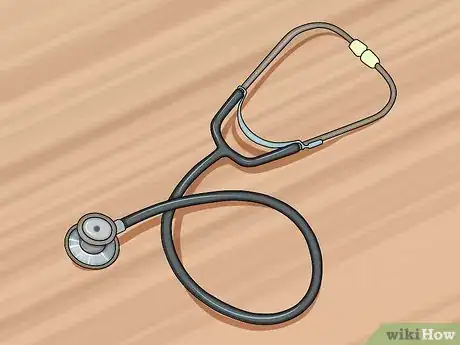

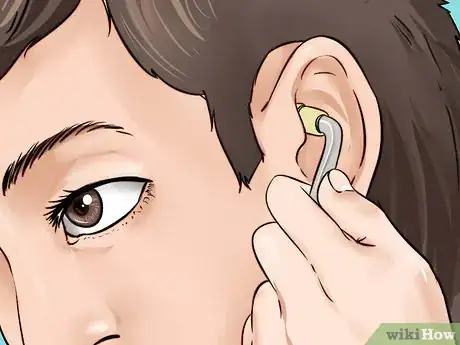



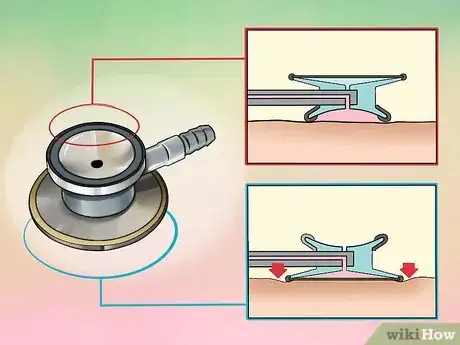


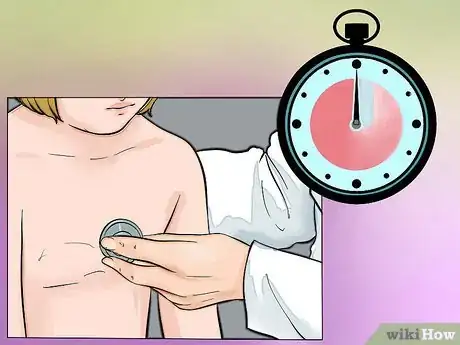

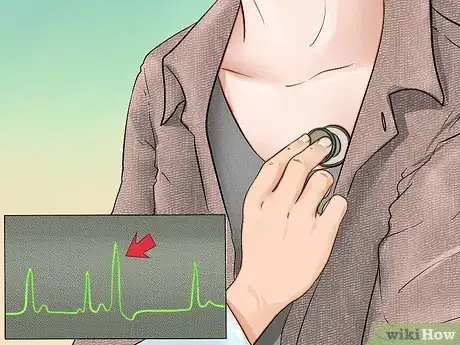

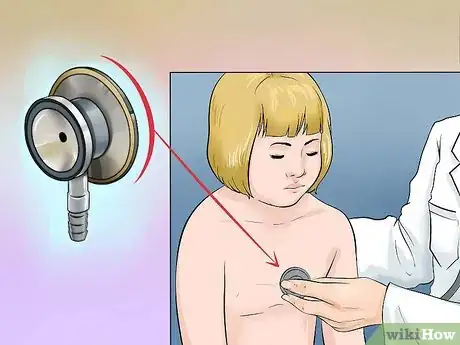

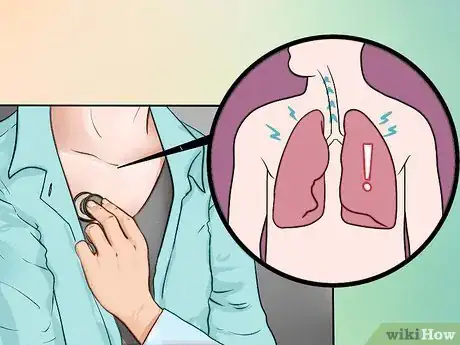






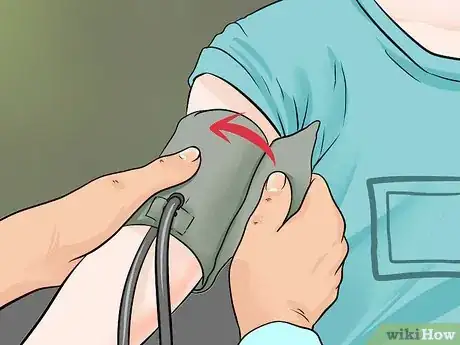
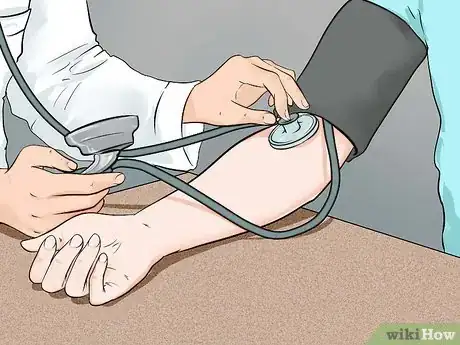
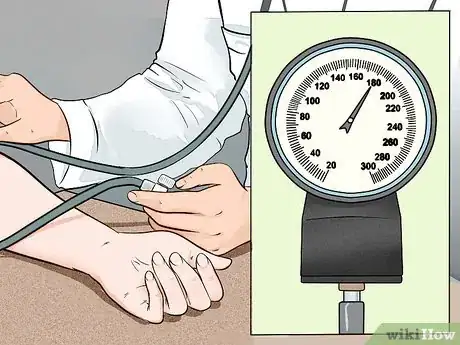


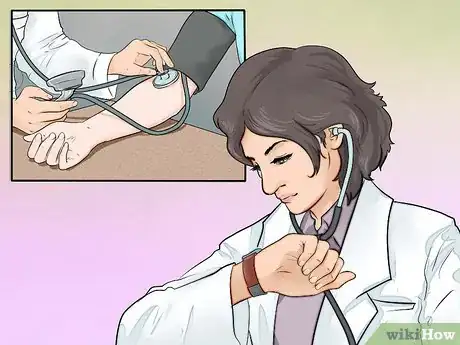


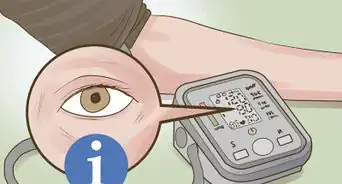




















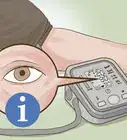




































Medical Disclaimer
The content of this article is not intended to be a substitute for professional medical advice, examination, diagnosis, or treatment. You should always contact your doctor or other qualified healthcare professional before starting, changing, or stopping any kind of health treatment.
Read More...